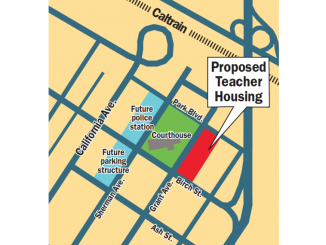
BY ALLISON LEVITSKY
Daily Post Staff Writer
Santa Clara County leaders yesterday (April 16) halted talks with Stanford over a development agreement related to the university’s proposed 3.5 million-square-foot expansion following word that the university had made a $138 million deal with the Palo Alto school district over the expansion plan.
The proposed agreement would only go into effect if Stanford and the county successfully negotiated a development agreement for the expansion.
County Board of Supervisors President Joe Simitian said yesterday that by making an offer to the school district that was contingent upon the outcome of Stanford’s separate talks with the county, the university was “pointing a gun at our heads” in order to get away with promising fewer mitigations for other impacts of the project such as housing, traffic and open space protections.
In negotiations with the county, the university could argue that if it didn’t get what it wanted, it would drop the deal with the school district. Simitian said the university was using the school district as leverage in its talks with the county, something he didn’t like.
Stanford’s deal with the school district also violates the ground rules of an agreement between Stanford and the county over negotiations for the development agreement, Simitian said.
Those ground rules prohibited both Stanford and the county from neogotiating with any other entity during negotiations over the development agreement.
Those ground rules expired at midnight Monday.
Simitian and Austin talk
Palo Alto Unified School District Superintendent Don Austin advised Simitian on April 5 that the district had reached a tentative agreement with Stanford on March 29.
Simitian said he asked Austin whether the agreement was conditional on action from the county, and that Austin said that no, it was not conditioned on any such giveaway.
Simitian mentioned that he took contemporaneous notes of this conversation.
But Austin told the Post yesterday that he did not think that was what Simitian meant. According to Austin, Simitian asked whether there were concessions in the agreement that required the county to do or concede things, and Austin responded that they had avoided those items.
Austin said that Simitian never mentioned the development agreement as a condition, and Austin “never thought that we would expect anything outside of a development agreement.”
“It may be the result of poor communication attributed to a lack of precise language between two people moving quickly and generally on the same page,” Austin said. “Any misunderstanding on this point was certainly unintentional.”
School board meets
The school board held a special meeting last night to discuss the proposed agreement. But only three trustees were on the dais. Todd Collins and Ken Dauber recused themselves because their wives work at Stanford.
Jean McCown, Stanford’s associate vice president for government and community relations, said at the meeting that the university remains “ready and willing” to re-enter negotiations with the county for a development agreement, which can include benefits outside of the conditions of approval imposed by the county.
“Stanford has not taken any issues off the table, including open space and traffic — and the university intends to abide by all of the mitigation measures recommended by the county’s final environmental impact report,” McCown said.
Board members and Austin lauded the offer from Stanford last night (Tuesday, Aug. 16). Without such an agreement, Stanford is only required by law to give the district $4.2 million in developer fees.
The proposed agreement includes a commitment from Stanford of about $121.9 million over 40 years, an average of $3.05 million a year, for per-student fees.
Those fees start at $5,800 per student and ramp up by 2% per year for the first 20 years, then decrease by 2% a year for the second 20 years. That’s significantly lower than the $19,200 that the district spends per student.
Austin defended that number last night by saying that almost no homes in Palo Alto generate that much property tax revenue for the district. The per-student spending comes from property taxes in addition to other sources, like state funds and donations.
Stanford expects to generate about 500 new K-12 students in the housing it plans to build for students and employees. Those students would be sent to Nixon and Escondido elementary schools, which already have 446 and 537 students, respectively.
The university is offering $1 million to accommodate those students at the existing campus schools and will give $15 million to build and furnish an “innovative space” on school district property where students and faculty from Stanford can “expand their collaboration” with the district.
But Stanford has made no firm commitment to build a third elementary school anytime soon, which had been a sticking point for the district.
Leaders from Stanford and the district would meet to discuss the “possibility” of a site in Palo Alto along Sand Hill Road, including the land currently occupied by the Oak Creek Apartments at 1600 Sand Hill, in 2032.
Correction: After this story was posted, Supervisor Simitian contacted the Post to say that the date of his phone conversation with Austin was April 5. Simitian inadvertently said during an interview Tuesday that the date was March 29. March 29 was the date when the district and Stanford reached a tentative agreement. The story above had been corrected.




Thank you for explaining Joe’s concerns about this. I read the other newspaper’s story and didn’t understand what his objection was all about.
Despite what Simitian is saying, I don’t think the school board should walk away from this deal. Stanford wants its permit so badly that it’s willing to offer over 100 million dollars. Who is to say they’ll be so generous after they get the permit?
Could somebody explain to me why $5800 per student is adequate compensation when the district’s costs run between $19,000 and $20,000 a student? Why isn’t Stanford paying full freight? Or, maybe a better way to put it, how do we taxpayers get the same discount Stanford is getting?
Glad to see that Simitian is calling B.S. on this offer from Stanford. Stanford has a $26 Billion endowment and they’re promising $138 million over 40 years. I think the school board could have held out for a better deal. … But in exchange for accepting this deal, the school board now becomes Stanford’s PAWN. If the county doesn’t give Stanford exactly what it wants, Stanford can hold PAUSD hostage. This is really cynical behavior by Stanford, but I shouldn’t be surprised given their role in the admissions scandal and coverup. THE SCHOOL BOARD SHOULD REALIZE THEY’RE BEING USED.
$138 million is nothing to sneeze at! Under state law, all Stanford is obligated to pay the school district is $4.2 million. I think the school board did pretty well for itself, even if Simitian is crying about it.
Thanks school board for undermining the only chance of regulating growth by Stanford. When are streets are gridlocked, the Arboritum is replaced by high rises and the housing shortage is so bad the average rent is $10,999 a month, we can look back and thank the school board for their wise actions. I’d write more but I’ve got to puke.
Stanford agreed not to negotiate with any other parties while they were in talks with the County over a Development Agreement. Then they blatantly violated that promise to make this deal with PAUSD. Given their behavior, why should we trust anything they say going forward? Why should the school board believe they’ll keep any of their promises.